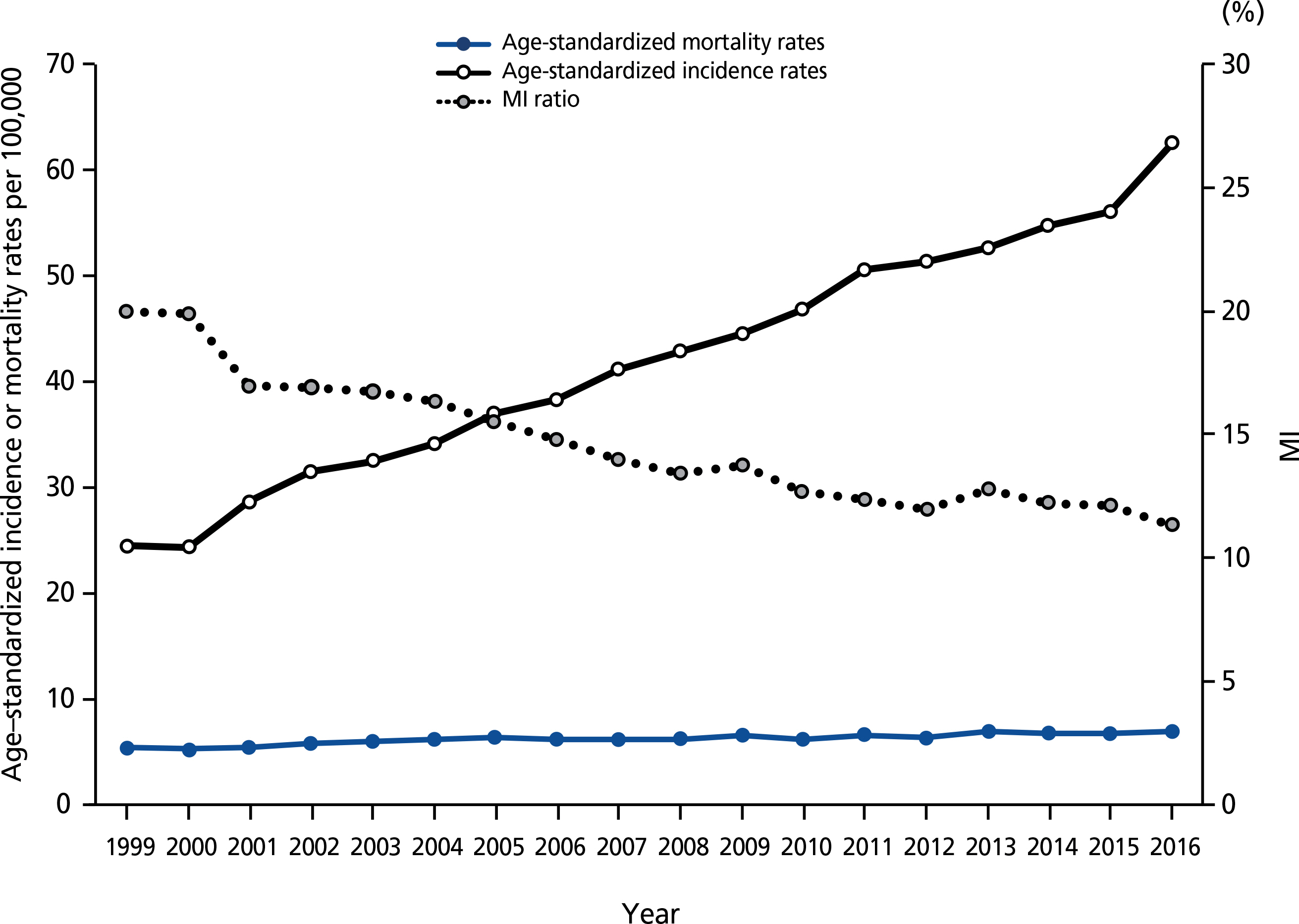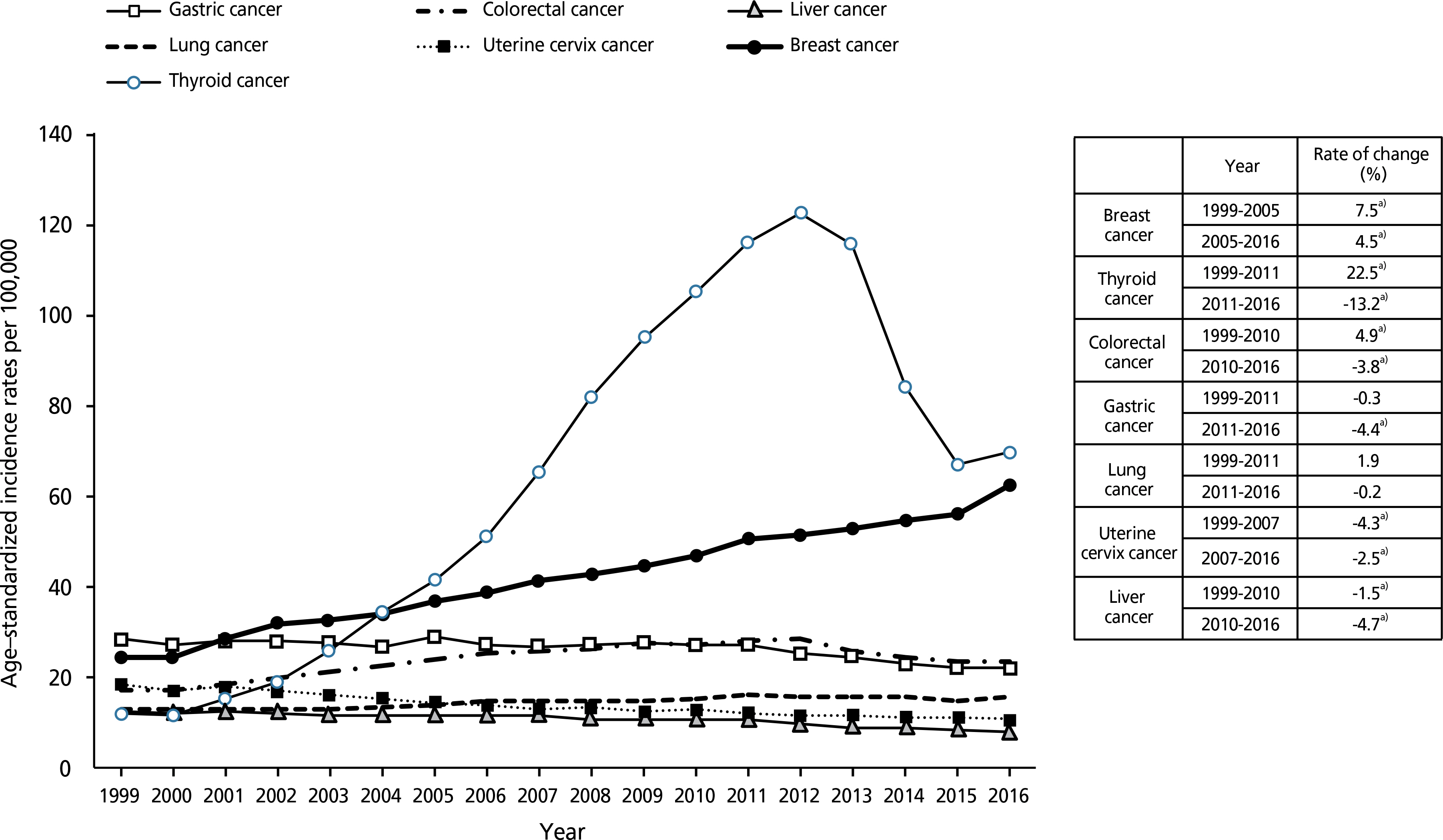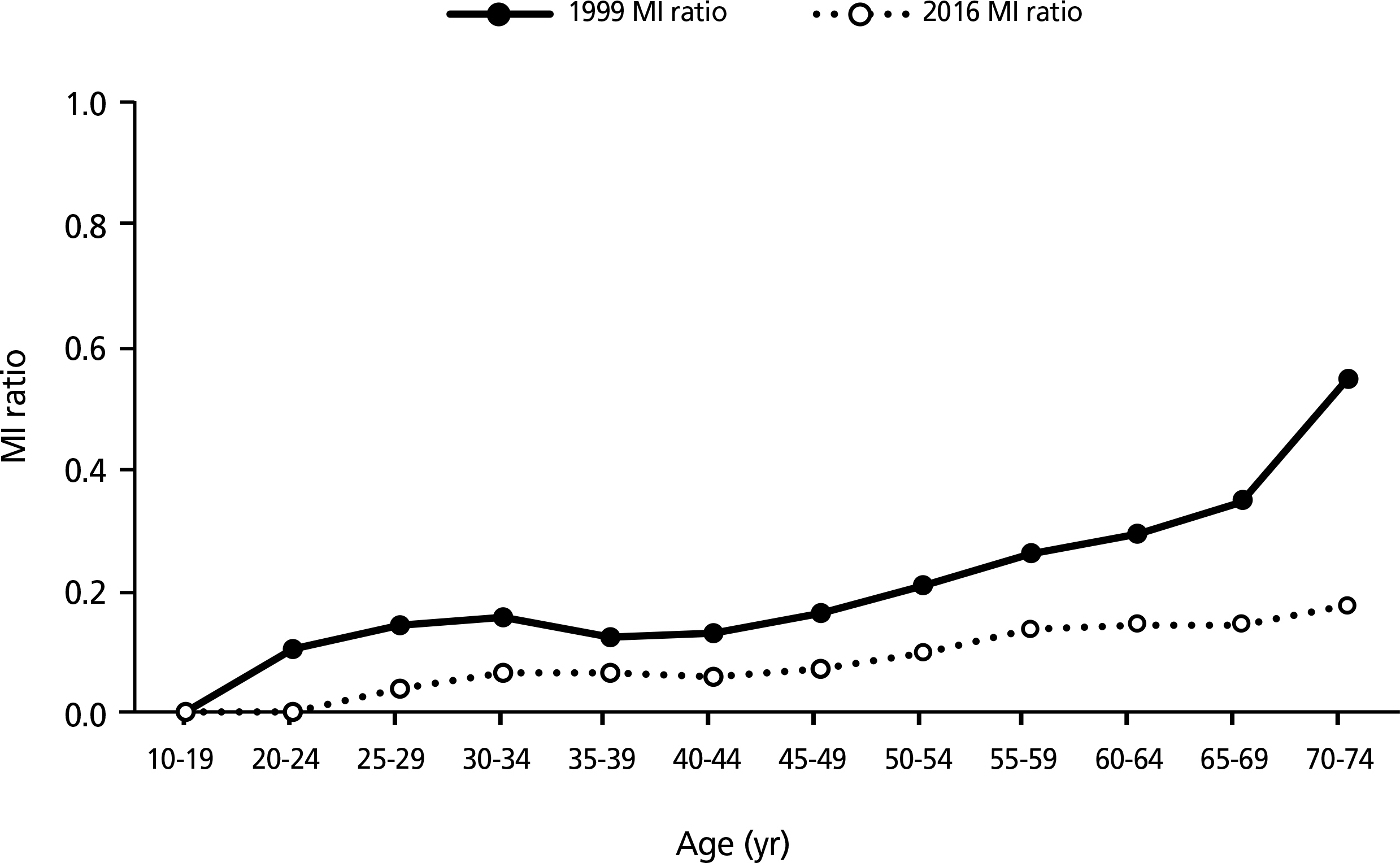J Korean Med Assoc.
2019 Aug;62(8):424-436. 10.5124/jkma.2019.62.8.424.
Epidemiological characteristics of breast cancer in Koreans
- Affiliations
-
- 1Department of Preventive Medicine, College of Medicine, Seoul National University, Seoul, Korea. suepark@snu.ac.kr
- 2Cancer Research Institute, Seoul National University, Seoul, Korea.
- 3Department of Biomedical Science, Graduate School, Seoul National University, Seoul, Korea.
- KMID: 2455379
- DOI: http://doi.org/10.5124/jkma.2019.62.8.424
Abstract
- In the ranking of cancer incidence in the year, female breast cancer was the highest cancer after thyroid cancer in 2004-2015, and became the most common cancer in 2016, exceeding the cases of thyroid cancer. The incidence rates of breast cancer have increased steadily over the past two decades and are expected to continue to increase in the next decades, although the incidence rates of all other cancers has declined in Korea. Most of the established risk factors of breast cancer are primarily related to female sex hormones. Other known risk factors are alcohol drinking, a family history of breast cancer, genetic predisposition, and benign breast conditions. Some risk factors, such as physical activity, breastfeeding, and number of children, are modifiable factors that can be targeted for risk reduction. This article summarizes the descriptive epidemiological characteristics of breast cancer in Korea that have been reported and identifies the specific characteristics and secular trends in incidence, mortality, and survival rates of breast cancer up to the present day. It is uncertain whether the risk factors established in western populations will also be valid for the Korean population. To explore this question, we summarize the results from international collaborative studies and meta-analyses of risk factors of breast cancer published to date. The results for Koreans are summarized and described based on results from population-based or nested case-control studies, hospital case-community control studies, cohort studies, and meta-analyses conducted in Korea. This study will be helpful for risk assessment, interventions, and prevention of breast cancer.
Keyword
MeSH Terms
-
Alcohol Drinking
Breast Feeding
Breast Neoplasms*
Breast*
Case-Control Studies
Child
Cohort Studies
Epidemiology
Female
Genetic Predisposition to Disease
Gonadal Steroid Hormones
Humans
Incidence
Korea
Mortality
Motor Activity
Risk Assessment
Risk Factors
Risk Reduction Behavior
Survival Rate
Thyroid Neoplasms
Gonadal Steroid Hormones
Figure
Cited by 2 articles
-
Association between breastfeeding and breast, thyroid, and cervical cancer among Korean adult women based on the Korean Genome and Epidemiology Study: a cohort study
Eunju Jin, Hyunju Kang, Mia Son
Korean J Women Health Nurs. 2021;27(4):368-378. doi: 10.4069/kjwhn.2021.11.29.Do lifestyle factors influence risk of breast cancer recurrence in Korean women?: a cross-sectional survey
So-Jung Park, Hye-Ah Yeom
Korean J Women Health Nurs. 2022;28(2):145-153. doi: 10.4069/kjwhn.2022.06.08.
Reference
-
1. Korean Statistical Information Service. Cause of death statistics [Internet]. Deajeon: Statistics Korea [cited 2019 Jul 3]. Available from:. http://kosis.kr/statisticsList/statisticsListIndex.do?menuId=M_01_01&vwcd=MT_ZTITLE&parmTabId=M_01_01.2. National Cancer Center. 2016 Korea cancer registry statistics. Goyang: National Cancer Center;2019.3. Noone AM, Howlader N, Krapcho M, Miller D, Brest A, Yu M, Ruhl J, Tatalovich Z, Mariotto A, Lewis DR, Chen HS, Feuer EJ, Cronin KA. SEER cancer statistics review (CSR) 1975-2015 [Internet]. Bethesda: National Cancer Institute;2018. [cited 2019 Jul 3]. Available from:. https://seer.cancer.gov/archive/csr/1975_2015/.4. Canadian Cancer Statistics Advisory Committee. Canadian cancer statistics: a 2018 special report on cancer incidence by stage [Internet]. Toronto: Canadian Cancer Society;2018. [cited 2019 Jul 3]. Available from:. http://cancer.ca/Canadian-Cancer-Statistics-2018-EN.5. National Cancer Center Japan. Monitoring of cancer incidence in Japan: survival 2006-2008 report [Internet]. Tokyo: Center for Cancer Control and Information Services, National Cancer Center Japan;2016. [cited 2019 Jul 3]. Available from:. https://ganjoho.jp/en/professional/statistics/table_download.html.6. International Agency for Research on Cancer; World Health Organization. Global Cancer Observatory: cancer today [Internet]. Lyon: International Agency for Research on Cancer [cited 2019 Jul 3]. Available from:. http://gco.iarc.fr/.7. Veurink M, Koster M, Berg LT. The history of DES, lessons to be learned. Pharm World Sci. 2005; 27:139–143.
Article8. Greenberg ER, Barnes AB, Resseguie L, Barrett JA, Burnside S, Lanza LL, Neff RK, Stevens M, Young RH, Colton T. Breast cancer in mothers given diethylstilbestrol in pregnancy. N Engl J Med. 1984; 311:1393–1398.
Article9. Beral V. Million Women Study Collaborators. Breast cancer and hormone-replacement therapy in the Million Women Study. Lancet. 2003; 362:419–427.10. Collaborative Group on Hormonal Factors in Breast Cancer. Breast cancer and hormone replacement therapy: collaborative reanalysis of data from 51 epidemiological studies of 52 705 women with breast cancer and 108 411 women without breast cancer. Lancet. 1997; 350:1047–1059.11. Hodis HN, Sarrel PM. Menopausal hormone therapy and breast cancer: what is the evidence from randomized trials? Climacteric. 2018; 21:521–528.
Article12. Schairer C, Lubin J, Troisi R, Sturgeon S, Brinton L, Hoover R. Menopausal estrogen and estrogen-progestin replacement therapy and breast cancer risk. JAMA. 2000; 283:485–491.
Article13. Collaborative Group on Hormonal Factors in Breast Cancer. Breast cancer and hormonal contraceptives: collaborative reanalysis of individual data on 53 297 women with breast cancer and 100 239 women without breast cancer from 54 epidemiological studies. Lancet. 1996; 347:1713–1727.14. Gierisch JM, Coeytaux RR, Urrutia RP, Havrilesky LJ, Moorman PG, Lowery WJ, Dinan M, McBroom AJ, Hasselblad V, Sanders GD, Myers ER. Oral contraceptive use and risk of breast, cervical, colorectal, and endometrial cancers: a systematic review. Cancer Epidemiol Biomarkers Prev. 2013; 22:1931–1943.
Article15. Bae JM, Kim EH. Hormone replacement therapy and risk of breast cancer in Korean women: a quantitative systematic review. J Prev Med Public Health. 2015; 48:225–230.
Article16. Park SB, Shin HR, Lee SY. A population-based cohort study of HRT use and breast cancer in Korea. Asia Pac J Public Health. 2012; 24:415–422.
Article17. Park B, Cho HM, Lee EH, Song S, Suh M, Choi KS, Kang BJ, Ko K, Yi A, Jung HK, Cha JH, Jun JK. Does breast density measured through population-based screening independently increase breast cancer risk in Asian females? Clin Epidemiol. 2017; 10:61–70.
Article18. Kim BK, Choi YH, Nguyen TL, Nam SJ, Lee JE, Hopper JL, Sung J, Song YM. Mammographic density and risk of breast cancer in Korean women. Eur J Cancer Prev. 2015; 24:422–429.
Article19. National Collaborating Centre for Cancer. Familial breast cancer: classification and care of people at risk of familial breast cancer and management of breast cancer and related risks in people with a family history of breast cancer. Cardiff: National Collaborating Centre for Cancer;2013.20. Collaborative Group on Hormonal Factors in Breast Cancer. Familial breast cancer: collaborative reanalysis of individual data from 52 epidemiological studies including 58 209 women with breast cancer and 101 986 women without the disease. Lancet. 2001; 358:1389–1399.21. Park B, Ma SH, Shin A, Chang MC, Choi JY, Kim SW, Han W, Noh DY, Ahn SH, Kang DH, Yoo KY, Park SK. Korean risk assessment model for breast cancer risk prediction. PLoS One. 2013; 8:e76736.
Article22. Park B, Choi JY, Sung HK, Ahn C, Hwang Y, Jang J, Lee J, Kim H, Shin HR, Park S, Han W, Noh DY, Yoo KY, Kang D, Park SK. Attribution to heterogeneous risk factors for breast cancer subtypes based on hormone receptor and human epidermal growth factor 2 receptor expression in Korea. Medicine (Baltimore). 2016; 95:e3063.
Article23. Shin MH, Yang JH, Choi KJ, Ahn YO. The menstrual, reproductive, and lactational factors and the risk of breast cancer in Korea: a population based case-control Study. Korean J Epidemiol. 2000; 22:68.24. Han SA, Park SK, Ahn SH, Lee MH, Noh DY, Kim LS, Noh WC, Jung Y, Kim KS, Kim SW. Korean Breast Cancer Study Group. The Korean Hereditary Breast Cancer (KOHBRA) study: protocols and interim report. Clin Oncol (R Coll Radiol). 2011; 23:434–441.
Article25. Han SA, Kim SW, Kang E, Park SK, Ahn SH, Lee MH, Nam SJ, Han W, Bae YT, Kim HA, Cho YU, Chang MC, Paik NS, Hwang KT, Kim SJ, Noh DY, Choi DH, Noh WC, Kim LS, Kim KS, Suh YJ, Lee JE, Jung Y, Moon BI, Yang JH, Son BH, Yom CK, Kim SY, Lee H, Jung SH. KOHBRA Research Group and the Korean Breast Cancer Society. The prevalence of BRCA mutations among familial breast cancer patients in Korea: results of the Korean Hereditary Breast Cancer study. Fam Cancer. 2013; 12:75–81.
Article26. Park B, Dowty JG, Ahn C, Win AK, Kim SW, Lee MH, Lee JW, Kang E, Hopper JL, Park SK. Breast cancer risk for Korean women with germline mutations in BRCA1 and BRCA2. Breast Cancer Res Treat. 2015; 152:659–665.
Article27. Collaborative Group on Hormonal Factors in Breast Cancer. Menarche, menopause, and breast cancer risk: individual participant metaanalysis, including 118 964 women with breast cancer from 117 epidemiological studies. Lancet Oncol. 2012; 13:1141–1151.28. Al-Ajmi K, Lophatananon A, Yuille M, Ollier W, Muir KR. Review of non-clinical risk models to aid prevention of breast cancer. Cancer Causes Control. 2018; 29:967–986.
Article29. Park B, Park S, Shin HR, Shin A, Yeo Y, Choi JY, Jung KW, Kim BG, Kim YM, Noh DY, Ahn SH, Kim JW, Kang S, Kim JH, Kim TJ, Kang D, Yoo KY, Park SK. Population attributable risks of modifiable reproductive factors for breast and ovarian cancers in Korea. BMC Cancer. 2016; 16:5.
Article30. Collaborative Group on Hormonal Factors in Breast Cancer. Breast cancer and breastfeeding: collaborative reanalysis of individual data from 47 epidemiological studies in 30 countries, including 50 302 women with breast cancer and 96 973 women without the disease. Lancet. 2002; 360:187–195.31. Gaudet MM, Patel AV, Sun J, Teras LR, Gapstur SM. Tubal sterilization and breast cancer incidence: results from the cancer prevention study II nutrition cohort and metaanalysis. Am J Epidemiol. 2013; 177:492–499.
Article32. Ma H, Bernstein L, Pike MC, Ursin G. Reproductive factors and breast cancer risk according to joint estrogen and progesterone receptor status: a metaanalysis of epidemiological studies. Breast Cancer Res. 2006; 8:R43.
Article33. Shin A, Song YM, Yoo KY, Sung J. Menstrual factors and cancer risk among Korean women. Int J Epidemiol. 2011; 40:1261–1268.
Article34. World Cancer Research Fund; American Institute for Cancer Research. Breast cancer: how diet, nutrition, and physical activity affect breast cancer risk [Internet]. London: World Cancer Research Fund International;2018. [cited 2019 Jul 12]. Available from:. https://www.wcrf.org/dietandcancer/breast-cancer.35. Lee SY, Kim MT, Kim SW, Song MS, Yoon SJ. Effect of lifetime lactation on breast cancer risk: a Korean women's cohort study. Int J Cancer. 2003; 105:390–393.
Article36. Lee EJ, Suh SW, Lee SK, Lee HS. Reproductive factor and food intake pattern influencing on the breast cancer risk in Daegu, Gyungbuk area, Korea. J Nutr Health. 2007; 40:334–346.37. Press DJ, Sullivan-Halley J, Ursin G, Deapen D, McDonald JA, Strom BL, Norman SA, Simon MS, Marchbanks PA, Folger SG, Liff JM, Burkman RT, Malone KE, Weiss LK, Spirtas R, Bernstein L. Breast cancer risk and ovariectomy, hysterectomy, and tubal sterilization in the women's contraceptive and reproductive experiences study. Am J Epidemiol. 2011; 173:38–47.
Article38. Gaudet MM, Gapstur SM, Sun J, Teras LR, Campbell PT, Patel AV. Oophorectomy and hysterectomy and cancer incidence in the Cancer Prevention Study-II Nutrition Cohort. Obstet Gynecol. 2014; 123:1247–1255.
Article39. Key J, Hodgson S, Omar RZ, Jensen TK, Thompson SG, Boobis AR, Davies DS, Elliott P. Metaanalysis of studies of alcohol and breast cancer with consideration of the methodological issues. Cancer Causes Control. 2006; 17:759–770.
Article40. Hamajima N, Hirose K, Tajima K, Rohan T, Calle EE, Heath CW Jr, Coates RJ, Liff JM, Talamini R, Chantarakul N, Koetsawang S, Rachawat D, Morabia A, Schuman L, Stewart W, Szklo M, Bain C, Schofield F, Siskind V, Band P, Coldman AJ, Gallagher RP, Hislop TG, Yang P, Kolonel LM, Nomura AM, Hu J, Johnson KC, Mao Y, De Sanjose S, Lee N, Marchbanks P, Ory HW, Peterson HB, Wilson HG, Wingo PA, Ebeling K, Kunde D, Nishan P, Hopper JL, Colditz G, Gajalanski V, Martin N, Pardthaisong T, Silpisornkosol S, Theetranont C, Boosiri B, Chutivongse S, Jimakorn P, Virutamasen P, Wongsrichanalai C, Ewertz M, Adami HO, Bergkvist L, Magnusson C, Persson I, Chang-Claude J, Paul C, Skegg DC, Spears GF, Boyle P, Evstifeeva T, Daling JR, Hutchinson WB, Malone K, Noonan EA, Stanford JL, Thomas DB, Weiss NS, White E, Andrieu N, Brêmond A, Clavel F, Gairard B, Lansac J, Piana L, Renaud R, Izquierdo A, Viladiu P, Cuevas HR, Ontiveros P, Palet A, Salazar SB, Aristizabel N, Cuadros A, Tryggvadottir L, Tulinius H, Bachelot A, Le MG, Peto J, Franceschi S, Lubin F, Modan B, Ron E, Wax Y, Friedman GD, Hiatt RA, Levi F, Bishop T, Kosmelj K, Primic-Zakelj M, Ravnihar B, Stare J, Beeson WL, Fraser G, Bullbrook RD, Cuzick J, Duffy SW, Fentiman IS, Hayward JL, Wang DY, McMichael AJ, McPherson K, Hanson RL, Leske MC, Mahoney MC, Nasca PC, Varma AO, Weinstein AL, Moller TR, Olsson H, Ranstam J, Goldbohm RA, van den Brandt PA, Apelo RA, Baens J, de la Cruz Jr, Javier B, Lacaya LB, Ngelangel CA, La Vecchia C, Negri E, Marubini E, Ferraroni M, Gerber M, Richardson S, Segala C, Gatei D, Kenya P, Kungu A, Mati JG, Brinton LA, Hoover R, Schairer C, Spirtas R, Lee HP, Rookus MA, van Leeuwen FE, Schoenberg JA, McCredie M, Gammon MD, Clarke EA, Jones L, Neil A, Vessey M, Yeates D, Appleby P, Banks E, Beral V, Bull D, Crossley B, Goodill A, Green J, Hermon C, Key T, Langston N, Lewis C, Reeves G, Collins R, Doll R, Peto R, Mabuchi K, Preston D, Hannaford P, Kay C, Rosero-Bixby L, Gao YT, Jin F, Yuan JM, Wei HY, Yun T, Zhiheng C, Berry G, Cooper Booth J, Jelihovsky T, MacLennan R, Shearman R, Wang QS, Baines CJ, Miller AB, Wall C, Lund E, Stalsberg H, Shu XO, Zheng W, Katsouyanni K, Trichopoulou A, Trichopoulos D, Dabancens A, Martinez L, Molina R, Salas O, Alexander FE, Anderson K, Folsom AR, Hulka BS, Bernstein L, Enger S, Haile RW, Paganini-Hill A, Pike MC, Ross RK, Ursin G, Yu MC, Longnecker MP, Newcomb P, Bergkvist L, Kalache A, Farley TM, Holck S, Meirik O. Collaborative Group on Hormonal Factors in Breast Cancer. Collaborative Group on Hormonal Factors in Breast Cancer. Alcohol, tobacco and breast cancer: collaborative reanalysis of individual data from 53 epidemiological studies, including 58,515 women with breast cancer and 95,067 women without the disease. Br J Cancer. 2002; 87:1234–1245.41. Allen NE, Beral V, Casabonne D, Kan SW, Reeves GK, Brown A, Green J. Million Women Study Collaborators. Moderate alcohol intake and cancer incidence in women. J Natl Cancer Inst. 2009; 101:296–305.
Article42. Bagnardi V, Rota M, Botteri E, Tramacere I, Islami F, Fedirko V, Scotti L, Jenab M, Turati F, Pasquali E, Pelucchi C, Galeone C, Bellocco R, Negri E, Corrao G, Boffetta P, La Vecchia C. Alcohol consumption and site-specific cancer risk: a comprehensive dose-response metaanalysis. Br J Cancer. 2015; 112:580–593.
Article43. Park S, Shin HR, Lee B, Shin A, Jung KW, Lee DH, Jee SH, Cho SI, Park SK, Boniol M, Boffetta P, Weiderpass E. Attributable fraction of alcohol consumption on cancer using population-based nationwide cancer incidence and mortality data in the Republic of Korea. BMC Cancer. 2014; 14:420.
Article44. Lauby-Secretan B, Scoccianti C, Loomis D, Grosse Y, Bianchini F, Straif K. International Agency for Research on Cancer Handbook Working Group. Body fatness and cancer: viewpoint of the IARC Working Group. N Engl J Med. 2016; 375:794–798.45. Park S, Kim Y, Shin HR, Lee B, Shin A, Jung KW, Jee SH, Kim DH, Yun YH, Park SK, Boniol M, Boffetta P. Population-attributable causes of cancer in Korea: obesity and physical inactivity. PLoS One. 2014; 9:e90871.
Article46. Cheraghi Z, Poorolajal J, Hashem T, Esmailnasab N, Doosti Irani A. Effect of body mass index on breast cancer during premenopausal and postmenopausal periods: a metaanalysis. PLoS One. 2012; 7:e51446.
Article47. Munsell MF, Sprague BL, Berry DA, Chisholm G, Trentham-Dietz A. Body mass index and breast cancer risk according to postmenopausal estrogen-progestin use and hormone receptor status. Epidemiol Rev. 2014; 36:114–136.
Article48. Lee KR, Hwang IC, Han KD, Jung J, Seo MH. Waist circumference and risk of breast cancer in Korean women: A nationwide cohort study. Int J Cancer. 2018; 142:1554–1559.
Article49. Park SK, Kang D, McGlynn KA, Garcia-Closas M, Kim Y, Yoo KY, Brinton LA. Intrauterine environments and breast cancer risk: metaanalysis and systematic review. Breast Cancer Res. 2008; 10:R8.
Article50. Gaudet MM, Gapstur SM, Sun J, Diver WR, Hannan LM, Thun MJ. Active smoking and breast cancer risk: original cohort data and metaanalysis. J Natl Cancer Inst. 2013; 105:515–525.
Article51. Macacu A, Autier P, Boniol M, Boyle P. Active and passive smoking and risk of breast cancer: a metaanalysis. Breast Cancer Res Treat. 2015; 154:213–224.
Article52. Jee SH, Samet JM, Ohrr H, Kim JH, Kim IS. Smoking and cancer risk in Korean men and women. Cancer Causes Control. 2004; 15:341–348.
Article53. Dyrstad SW, Yan Y, Fowler AM, Colditz GA. Breast cancer risk associated with benign breast disease: systematic review and metaanalysis. Breast Cancer Res Treat. 2015; 149:569–575.
Article54. Pettersson A, Graff RE, Ursin G, Santos Silva ID, McCormack V, Baglietto L, Vachon C, Bakker MF, Giles GG, Chia KS, Czene K, Eriksson L, Hall P, Hartman M, Warren RM, Hislop G, Chiarelli AM, Hopper JL, Krishnan K, Li J, Li Q, Pagano I, Rosner BA, Wong CS, Scott C, Stone J, Maskarinec G, Boyd NF, van Gils CH, Tamimi RM. Mammographic density phenotypes and risk of breast cancer: a metaanalysis. J Natl Cancer Inst. 2014; 106:dju078.
Article55. Jeong SH, An YS, Choi JY, Park B, Kang D, Lee MH, Han W, Noh DY, Yoo KY, Park SK. Risk reduction of breast cancer by childbirth, breastfeeding, and their interaction in Korean women: heterogeneous effects across menopausal status, hormone receptor status, and pathological subtypes. J Prev Med Public Health. 2017; 50:401–410.
- Full Text Links
- Actions
-
Cited
- CITED
-
- Close
- Share
- Similar articles
-
- Epidemiological Characteristics of Breast Cancer in Korea
- Clinical characteristics of Korean breast cancer patients in 1998. The Korean Breast Cancer Society
- Clinicopathological characteristics of BRCA-associated breast cancer in Asian patients
- Clinical Characteristics of Breast Cancer Patients in Korea in Year 2000
- Nationwide Korean Breast Cancer Data of 2002 The Korean Breast Cancer Society







